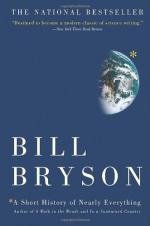|
This section contains 346 words (approx. 1 page at 400 words per page) |

|
Part 5, Chapter 16 Summary and Analysis
As far as anyone knows for certain, life only exists on one tiny wedge of one planet, Earth. The space that's suitable for life is less than 12 miles deep on the Earth's surface. By volume, water covers 99.5 percent of the planet's habitable space.
A surprising amount of the land on the Earth is too hot or too cold to be habitable by humans. Only about 12 percent of the land, or four percent of the total surface of the planet, is suitable. Despite Earth's rigors, other planets are even less hospitable. Even Earth itself was less hospitable in times past.
There are 92 elements occurring naturally on Earth, and about 20 more that have been created in labs. Only 30 are widespread and only six are central to life. Carbon is the 15th most common element, but the one on which most life...
(read more from the Part 5, Chapter 16 Summary)
|
This section contains 346 words (approx. 1 page at 400 words per page) |

|




